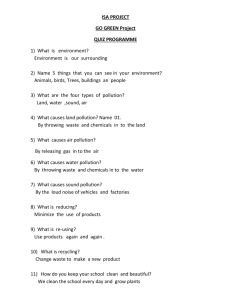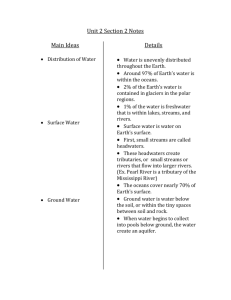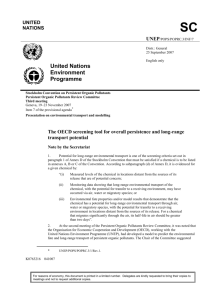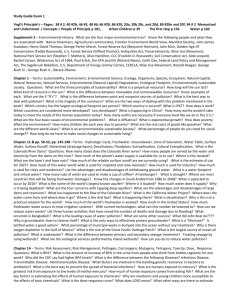Academia’s Role for Sound Chemicals Management: Stockholm Convention and
advertisement
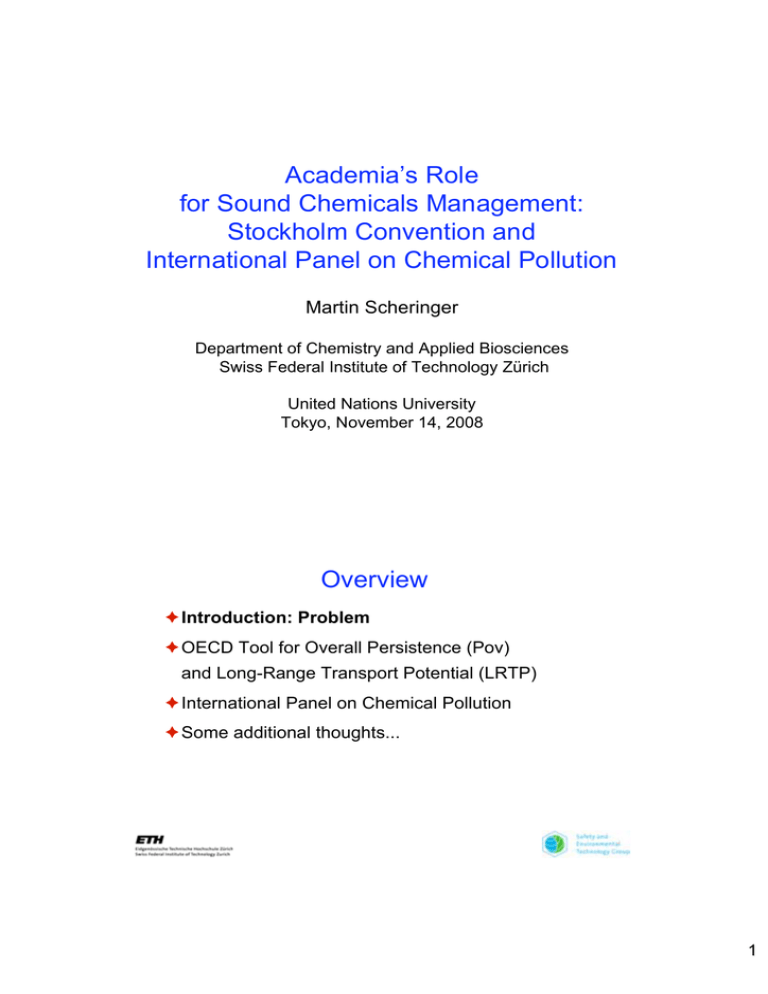
Academia’s Role for Sound Chemicals Management: Stockholm Convention and International Panel on Chemical Pollution Martin Scheringer Department of Chemistry and Applied Biosciences Swiss Federal Institute of Technology Zürich United Nations University Tokyo, November 14, 2008 Overview Introduction: Problem OECD Tool for Overall Persistence (Pov) and Long-Range Transport Potential (LRTP) International Panel on Chemical Pollution Some additional thoughts... 1 The Stockholm Convention on Persistent Organic Pollutants (I) Entry into force: May 17, 2004 152 signatories (2008) chm.pops.int The Stockholm Convention on Persistent Organic Pollutants (II) Initial set of chemicals: „dirty dozen“ DDT toxaphene 2,3,7,8-TCDD PCBs hexachlorobenzene Additional chemicals under consideration: PBDEs, HCHs, PFOS, PeCB, SCCP, HBB, chlordecone etc. endosulfan – also HBCD? 2 The Stockholm Convention on Persistent Organic Pollutants (III) POPs criteria in Annex D: Persistence: 40 d (water), 180 d (sediment, soil) LRTP: various types of evidence; t1/2,air > 2 d Bioaccumulation: BCF > 5000, log Kow > 5 Toxicity: various types of evidence POP Review Committee Review of chemicals proposed for inclusion in Annexes A, B, C of the convention Meetings in fall every year (October 2008: POPRC-4) The Stockholm Convention on Persistent Organic Pollutants (IV) Conference of the parties: COP4 (2009) Convention important international legal agreement Also: convention creates needs for scientific input Stockholm Convention on Persistent Organic Pollutants Conference of the Parties 3 Transfer of Knowledge: Obstacles Information not available because needs of users do not overlap with interest/objectives of scientists Scientists not aware of needs of users „Format mismatch“ Scientists not aware that users may not search for journal articles Scientists do not have capacity to present results in different format – additional effort that is not appreciated by academic environment! Transfer of Knowledge: Solutions Mismatch of objectives and needs not a „failure“... ... but a consequence of different inherent structure of academic science and politics/administration scientific officer academia international institution scientist journal publication ? 4 Transfer of Knowledge: Solutions Mismatch of objectives and needs not a „failure“... ... but a consequence of different inherent structure of academic science and politics/administration scientific officer academia ? ? scientist journal publication international institution ? Transfer of Knowledge: Solutions Mismatch of objectives and needs not a „failure“... ... but a consequence of different inherent structure of academic science and politics/administration Possible solution: institutional interface scientific officer academia international institution scientist journal publication interface institution 5 Overview Introduction: Problem OECD Tool for Overall Persistence (Pov) and Long-Range Transport Potential (LRTP) International Panel on Chemical Pollution Some additional thoughts... Background of the OECD Tool (I) October 2001: OECD/UNEP workshop in Ottawa 6 Multi-Media Models Convenient analytical framework for the investigation of environmental processes Background of the OECD Tool (II) October 2001: OECD/UNEP workshop in Ottawa Recommendations: Provide „guidance for users on model applicability and fitness for purposes” Model intercomparison studies should be conducted „A core set of multimedia models should be available and accessible at no cost to the public.” “Expert Group for the Follow-up to the OECD/UNEP Workshop on Multimedia Models” established in 2002 7 OECD Model Comparison Expert Group Robert S. Boethling, United States Environmental Protection Agency, USA Mark Bonnell, Environment Canada, Gatineau, Canada Kathrin Fenner, EAWAG, Dübendorf, Switzerland Anne Christine Le Gall, INERIS, France Andreas Beyer, Jörg Klasmeier, Michael Matthies, University of Osnabrück, Germany Matthew MacLeod, Martin Scheringer, Maximilian Stroebe, ETH Zürich, Switzerland Donald Mackay, Trent University, CEMC, Canada Tom McKone, Lawrence Berkeley Laboratory, California, USA David Pennington, Joint Research Centre, Ispra, Italy Bernd Scharenberg, Fed. Environment Agency, Berlin, Germany Noriyuki Suzuki, Nat. Institute for Env. Studies, Tsukuba, Japan Dik van de Meent, RIVM, Bilthoven, The Netherlands Frank Wania, University of Toronto, Canada Work of the Expert Group Guidance document, published in 2004: 8 Work of the Expert Group Guidance document, published in 2004 1st model comparison study, published in 2005: Environ. Sci. Technol. 39, 2005, 1932–1942 Work of the Expert Group Guidance document, published in 2004 1st model comparison study, published in 2005 2nd model comparison study, published in 2008: J. Environ. Monit. 10, 2008, 1139–1147 9 Work of the Expert Group Guidance document, published in 2004 1st model comparison study, published in 2005 2nd model comparison study, published in 2008 Use of reference chemicals for identification of Pov and LRTP, published in 2006: Environ. Sci. Technol. 40, 2006, 53–60 An Unexpected Step Spirit of good collaboration and trust Impact of expert group stronger than of single scientists Endorsement of a consensus model Model developed in 2004, funding from Germany and Switzerland via OECD Since 2008, model available from OECD website: http://tinyurl.com/66q47j 10 The Tool: User Interface and Input Data Left: databases Right: single chemical Chemical property data required: log10 Kaw log10 Kow degradation half-lives air water soil F. Wegmann et al., Environ. Model. & Software 24 (2009), 228–237 OECD Tool: Results Left graph: Characteristic Travel Distance (CTD) vs. Pov Right graph: Transfer Efficiency (TE) vs. Pov 11 OECD Tool: Results Left graph: Characteristic Travel Distance (CTD) vs. Pov Right graph: Transfer Efficiency (TE) vs. Pov CCl4 HCB CCl4 HCB with lines for comparison with POP reference chemicals; Klasmeier et al. (2006) -HCH PCB-101 PCB-180 -HCH PCB-28 PCB-180 PCB-101 PCB-28 ethanol ethanol Results for POP Candidates 2006 Penta-BDE, -HCH, hexabromobiphenyl, chlordecone, PFOS penta-BDE, -HCH, HBB, chlordecone: lower Pov and higher LRTP than the group of DDT, toxaphene, dieldrin, chlordane, TCDD PFOS: higher Pov and CTD report available from ETH Zürich: http://www.sust-chem. ethz.ch/downloads with lines for comparison with reference chemicals 12 Results for POP Candidates 2007 -HCH, -HCH, PeCB, octa-BDE, SCCP lower Pov and in some cases higher LRTP than the group of DDT, toxaphene, dieldrin, chlordane, TCDD report available from ETH Zürich: http://www.sust-chem. ethz.ch/downloads with lines for comparison with reference chemicals Conclusions OECD Tool The Tool is a ... ... lasting outcome of the work of the OECD expert group ... platform for screening-level assessment of POP candidate chemicals 13 Overview Introduction: Problem OECD Tool for Overall Persistence (Pov) and Long-Range Transport Potential (LRTP) International Panel on Chemical Pollution Some additional thoughts... Is Chemical Pollution Serious on a Global Scale? Need to set priorities among different environmental problems: Climate change Biodiversity loss Water scarcity ... 14 Is Chemical Pollution Serious on a Global Scale? Need to set priorities among different environmental problems: Climate change Biodiversity loss Water scarcity Chemical pollution On a global and long-term scale, chemical pollution may affect the hormonal/sexual and intellectual development of a large number of humans. Is Chemical Pollution Serious on a Global Scale? Effects on intellectual development: Example Children in Mexico, exposed to pesticides E. A. Guillette et al. Environ. Health Perspect. 106 (1998), 347–353 15 What are the Problems to be Adressed? Chemical property data and findings on exposure and effects not harmonized. High uncertainties limit a science-based treatment of transboundary chemical pollution. Support and funding for measuring chemical properties, compiling emission inventories, conducting monitoring programs, performing modeling studies still too low. Existing organizations limited in their resources or their geographical or thematic scope. Examples ... Emission inventories Pesticide stockpiles Source: T. Kukharchyk, Belarus Source: UN News Pesticide cans in a dump in Mali Risk-benefit assessment of DDT usage Source: WHO DDT indoor residual spraying 16 Tasks of the IPCP Provide scientific support for politics Compile and evaluate existing results of research into large-scale chemical pollution Provide evaluated results for decision makers: IPCP reports on priority topics Encourage political support for science Create awareness among policy makers; support funding Put emphasis on fields not part of the scientific mainstream, e.g. chemical property measurements IPCP Declaration Describes IPCP initiative, open for signature, see www.ipcp.ch Supported by about 100 scientists from 35 countries Initiative to establish an International Panel on Chemical Pollution, IPCP The production of chemicals is an important source of economic welfare and chemical products provide a multitude of benefits for modern societies. However, many chemicals also enter the environment and chemical pollution will remain a major environmental issue in many regions of the world. To reduce levels of pollution and ensure safe production, use and disposal of chemicals, large scientific, technical and political efforts will be required. To address this need, we propose to establish an International Panel on Chemical Pollution, IPCP. The main task of this panel will be to provide support for decision makers dealing with pollution problems and the assessment and management of chemicals, both at the national and international level and based on the state of the science. (...) 17 IPCP Overview Description of IPCP objectives and context Environ. Sci. Pollut. Res. 13, 432–434 (2006) Organization of the IPCP (I) IPCP is a global network of scientists from chemistry engineering toxicology epidemiology ecotoxicology medicine ... Focus of IPCP work is on ... ... scientific evaluation of pollution problems ... fostering research needed to improve chemicals assessment ... delivering this scientific input to policy makers 18 Organization of the IPCP (II) Bodies: Steering committee and chair Working groups and project consortia Advisory board Institutional partners steering committee (6 members) chair advisory board institutional partners partner 1 partner 2 working group 2 project consortium 1 … … working group 1 Organization of the IPCP (III) Partners for collaboration and information exchange: Scientific societies such as SETAC, IUPAC, ACS, EuCheMS, SOT, ... Strategic Approach to International Chemicals Management (SAICM) International conventions International institutions National governments Industry associations ... 19 Starting Points of IPCP Work (I) Working groups: around 10 members, including chair or co-chairs focusing on selected priority topics, example: IPCP WG on Biomonitoring and Human Exposure (chair: G. Becher, Norway) Prepare reports or guidance documents on priority topics Show scientific consensus, uncertainties, disagreement, needs for further research Delivered to governments and all interested parties, available to the public from IPCP web site Starting Points of IPCP Work (II) Regional networks addressing specific needs of a region organizing scientific exchange and collaboration within the region using IPCP as a platform to present the situation in the region to other regions, countries, IPCP partners, ... Individual projects and activities Summer schools organized/supported by IPCP members ... 20 Conclusions IPCP IPCP initiative still in its initial stage Legal status for IPCP by end of 2008 Broad scope; high flexibility due to working group structure www.ipcp.ch Overview Introduction: Problem OECD Tool for Overall Persistence (Pov) and Long-Range Transport (LRTP) International Panel on Chemical Pollution Some additional thoughts... 21 Why is This Process so Complicated? “Applied Science”? Applied Science? Scientific support of the implementation of the Stockholm Convention is not applied science. Scientific results will be „applied“ in a practical context ... ... but: it is not clear what type of result will be needed, what kind of measurement or modeling technique should be used, etc. goals of relevant research still have to be defined new methods, concepts, techniques have to be developed, which will involve fundamental research 22 Applied Science? Example Research into Climate Change: Highly important in many applied contexts (technology, economy, ecosystem management, agriculture, health, ...) IPCC reports – and interprets – results from fundamental research in physics, chemistry, ... Scientific Input for Societal Problem Solving Model for interaction between science and politics: International institution; government agency; industry complex problem or issue Academic institutions 23 Scientific Input for Societal Problem Solving Model for interaction between science and politics: International institution; government agency; industry complex problem or issue Interface institution learn about problem Academic institutions Scientific Input for Societal Problem Solving Model for interaction between science and politics: International institution; government agency; industry complex problem or issue Interface institution analyze problem Academic institutions 24 Scientific Input for Societal Problem Solving Model for interaction between science and politics: International institution; government agency; industry complex problem or issue interested in methods, tools, possible solutions methods, tools, possible solutions accepted in general implementation of methods, tools, possible solutions Interface institution analyze problem methods, tools, possible solutions Academic institutions 25

